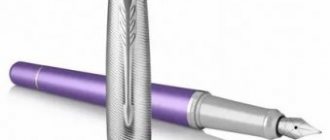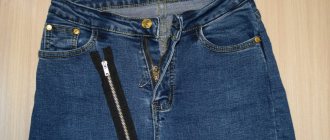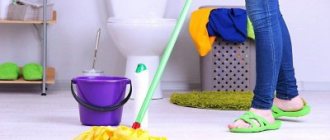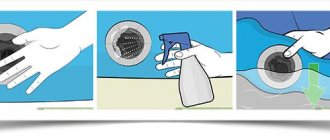What to do if the pen doesn't write? Of course, this stationery item is inexpensive, and you can always buy a new one. But sometimes with each new purchase we get another problematic pen - they either don’t write at all or stop leaving marks on the paper after a while.
And many people are concerned about the question of whether they can somehow be revived. So, here you can find out what to do if the pen does not write.
Types of faults
What could be wrong with your pen? There are quite a lot of malfunctions, we list the most common ones:
- The new pen writes intermittently, in strokes, and a creak is heard.
- The pen doesn't write after it hasn't been used for a while.
- The paste has dried out.
- The ballpoint pen is missing a ball.
- The paste has leaked out of the rod.
In order to determine why the pen does not write and what to do if there is no way to immediately buy a new one, you need to carefully examine it. Most often, the cause of the malfunction is determined fairly quickly, after which it is necessary to decide whether it is possible to somehow revive it and bring it into working condition.
What affects the characteristics
The writing characteristics of pens depend on the following factors:
- Type of handle . Ballpoint pens are the least demanding. Feathers require the most careful treatment.
- Quality of the rod (paste) . Poor quality rods may leak or dry out quickly.
- Temperature . At high temperatures, the ink begins to flow, and at low temperatures it freezes and stops writing.
- Availability of a cap . Almost all pens should be stored in a cap to prevent the paste from drying out.
What to do if the pen does not write
- If a ballpoint falls out of a ballpoint pen, it cannot be saved. You won't be able to insert the ball, but you can get the paste dirty from head to toe. Accept the loss.
- If the paste of a gel or ballpoint pen has leaked out of the refill, the easiest way is to throw it away, since when cleaning it and subsequent use there is a high chance of staining both yourself and the environment. But if there is no choice, then disassemble the mechanism on sheets of paper and wipe each part with wet wipes. Then assess the level of paste in the rod, blow it out and assemble the handle.
- A new pen often writes poorly due to poor ball break-in. This is why a new pen needs to be painted, and in some cases, a little more effort than usual.
- If a pen doesn't write after it hasn't been used for a couple of months, it usually means the paste has thickened too much. And if you don’t use it even longer, the paint inside the rod will completely dry out. To solve this problem, experts advise using one of two methods. The first is to heat the metal tip with a lighter to soften the ink. It is not recommended to use it due to the fact that open fire is unsafe. In addition, this way you will most likely just melt the plastic rod. The second way is to hold the rod under hot water. This technique is safer. If it is not possible to use hot water, then you can simply rub the rod in your palms.
Tips for calligraphers: how to store work supplies
On the Internet you will find a lot of information about what calligraphy supplies to choose and how to use them, but very little about how to store them! While devoting your energy to the art of calligraphy, do not forget that your direct assistants in this also require attention!
Below you will find some good tips for storing calligraphy tools.
We all have different environments, and we zealously organize our things in our own way. So, it is natural that different artists may have differences in the way they store their supplies. In this article I will show and tell you how I do it myself. I hope this helps you: 1) make sure you're not making mistakes, 2) maybe come up with a couple of new ideas.
Fountain pens for calligraphy
My way of storing pens is simple. I keep them in a mug, with feathers on and in full combat readiness. But there is a nuance that should not be forgotten: always check the dryness of the pen before putting your pen into the glass/container. A little humidity is not a problem - the pen will dry quickly. However, excess moisture will cause rust on the nib and handle (if it has metal parts).
The size and shape of the selected container does not play a special role.
Extra feathers
There’s nothing complicated here either: you can store your feathers in almost anything, as long as it keeps them safe (protects them from bending) and dry.
Any container you like will do. For example, a small tin jar. Those who like strict organization will love the idea of storing feathers in a pill container - this way you can always find the feather you need without a lot of searching.
Ink
Some inks come in convenient containers that you can start dipping your nibs into right away. But most inks require a more convenient container to work with. It is better to use containers with screw-on lids. A size of 30-60 grams would be ideal. Small jars of cosmetics will come to your aid in this matter! Or something similar.
I recommend screw caps for one reason: with snap lids, you run the risk of jumping through a lot of hoops to get the ink out of the bottle. Starting from dirty fingers and ending with a flooded table. However, look for yourself.
In short, a small jar with a screw cap is the best way to safely and airtightly store your ink.
Water
To store your “creative water” - the water with which you clean your feathers and brushes - you can choose any container you like! I keep water in an old mug for two reasons: first, I like it; secondly, the circles are stable. I can’t count how many times I accidentally hit the mug with my hand, and it heroically withstood the onslaught! Good old, ink-stained mugs have actually saved many of my creations from spills!
Paper
The paper should remain flat. The rest is a matter of your convenience. I store paper upright on a shelf. But in this case it should be fixed. Otherwise, bends and bruises cannot be avoided. You can also store it horizontally on a shelf or in a desk drawer.
Work rags
In my case, it's just old kitchen cloths, and I keep them on the back of my chair! I just make sure I put them there every time after work, because if I absentmindedly throw them away God-knows-where, I have no hope of finding them again! I have two identical napkins that “work in shifts.” They are already 3-4 years old, and I am sure they will last at least as long. The main thing is that the napkin can dry your brushes and feathers. Of course, you can store rags in a drawer - whatever is more convenient for you!
Worksheets
Storing sheets in folders on all kinds of rings is fraught with difficulty - these same rings will greatly constrain your hand when writing, and the rest of the sheets will get in the way. So I recommend just using a stapler/paper clip in the top left corner.
Finished works
You may be wondering why this point is here. There is a reason. Keeping examples of your work nearby is a good idea. I'm not advocating that you store all your work around you. Just keep at least two works in front of you and update them every 1-2 months. And if you suddenly feel discouraged, just look at what you did most recently. I guarantee you will see your progress! I always have a folder with my old works at hand, and every time I look through it I enjoy my progress.
The most important thing in storing your favorite accessories is convenience! As long as everything is safe and you have no problems quickly finding the item you need, everything is fine!
Source: The Postman's Knock
A fountain pen
What to do if your fountain pen doesn't write? Typically, inexpensive items suffer from this problem, while exclusive hand-built models are less susceptible to such malfunctions. But occasionally problems arise for them too.
If the new pen writes intermittently and with a slight squeak, this is a break-in problem, exactly the same as with a ballpoint analogue. The pen needs to be painted, and this takes time and patience.
But what to do if the problem does not disappear over time? Most likely, the problem is the factory lubricant that has clogged the feeder channels. Occasionally, tiny metal shavings may end up there. In case of this problem, it is recommended to rinse the pen:
- Disassemble the mechanism.
- Rinse under running water to remove the ink. Use only cold water, as hot water can deform some parts.
- Soak the feather for 1-2 hours in clean water.
- Dry the handle. The procedure will take from 12 to 24 hours.
- Assemble the mechanism.
Also, washing a fountain pen should be done if it has not been used for a long time and there is a risk that the ink has dried out. If the pen malfunction cannot be resolved by washing, you should contact customer service.
Corrector pen
A correction pen is an indispensable attribute of any student. It is found in any office and often helps out when you need to quickly and quietly correct a mistake. But what to do if the corrector pen does not write?
In fact, they dry out quite quickly and also often begin to leak, which complicates the work.
If the new correction pen does not write, then it must be shaken well for several minutes. Then remove any leaking marks on the tip. And you can start working.
If this doesn't work, try pressing harder when correcting mistakes - this will release more of the corrective agent. In cases where the corrector is water-based, when it dries out, you can soak the tip and the pen will work again.
We answer the reader’s question, analyze the reasons, and give advice.
I rarely use a pen. There is a smartphone for notes and reminders. Sometimes you have to sign contracts, postcards, and make some notes. But not that often. It happens that I don’t use it for a month or two. I like gel pens because they write beautifully and richly. But there is a problem - they quickly stop writing. It’s especially disappointing when the pen is brand new and has only been used twice. Why is this happening? What should you pay attention to when purchasing, so as not to end up in such situations again?
Thanks for the questions, Roman. Let's look at them in order.
Why did my almost new gel pen stop writing?
As the name suggests, the core of a gel pen is filled with a viscous substance. It is this thick consistency that we should be grateful for for the beautiful rich and glossy mark on the paper. This property is especially appreciated by artists who create amazing illustrations using gel pens.
For the same reason, the writing substance in the rod quickly runs out. Faster than any other type of pen. Therefore, it is extremely irrational to use them for notes. Also, the gel may dry out if the handle is located close to the heater. Or when it is stored without a cap.
But most modern manufacturers add special substances to the gel that maintain the viscosity of the substance longer. On average, the shelf life of a gel rod is from 2 to 3 years.
Sometimes, with infrequent use, the gel dries out on the ball. And yes, in such cases the pen also stops writing. In such cases, you need to write the pen well. If that doesn't help, wipe the ball with nail polish remover.
And most importantly, never place a gel pen with the writing side facing up. While you are not using it, the contents of the rod will slide down. The pen will stop writing. It can only be thrown away.
These tips will extend the life of any pen that has a ballpoint writing element - gel, rollerball, ballpoint.
How to use Parker correctly?
(rice.
- Unscrew the sleeve. ...
- Dip the nib into the bottle until it is completely submerged to prevent air from getting into the filler (never dip the filler into the ink, just the nib); Screw the piston back as far as it will go. ...
- Remove the feather from the bottle; release three drops of ink by turning the plunger.
Interesting materials:
When is the old-age social pension granted? When does carp not bite? When cannot an adverbial phrase be used? When is it too late to plant potatoes? When did the GDR disappear? When is the Present Continuous not used? When should you not warm your feet? When should you not use Tarot? When should you not clean before Easter? When do Germans change their clocks?
What to look for when buying a pen for occasional use?
Let's look at the options for pens that meet the requirements - they write beautifully and do not dry out for a long time.
Immediately sweep away the liners and capillary ones. Undoubtedly, they write beautifully, elegantly and are even suitable for calligraphy. But there is a significant drawback - they dry out quickly. Because they are actually felt-tip pens, but made using pen technology.
Ballpoint pens last the longest because the paste contains an oil rather than a water-based substance. The shelf life of such pens is from 2 to 5 years. But not all of them write beautifully. Cheap ones can smear, skip, and leave an unevenly saturated mark. For inexpensive models, you should take a closer look at the Uni and Pilot brands. They write richly and accurately.
With rollerballs, you don't have to worry about the ball spoiling or the contents of the rod sliding down. Simply because the ball rotates 360 degrees, and the writing is made of water. The shelf life is generally 2-3 years. But for some manufacturers, for example Pentel, it can reach 5 years. The rollerballs write beautifully and are pleasant to use.
Why pens leak - how to properly store ballpoint pens and refills AKVAREL
Why do pens leak?
Each of us has more than once encountered in life the fact that a ballpoint pen began to flow and get dirty with ink at the most inopportune moment, causing a lot of negative emotions from undisguised annoyance to righteous anger. Your hands are dirty, your favorite notebook with important notes is smeared, and your expensive shirt is ruined. How can you not get upset? Why do pens leak and how to deal with it?
Really, all you need to know about the problems with ballpoint pens is that some of them leak. First of all, this applies to low-quality specimens in which a rod made of cheap materials is installed. The most important component of the refill is the writing ball assembly, through which the paste or gel is delivered. They pass through a narrow gap between the metal end of the rod and the ball rolled into it.
If the metal of the rod or ball is too soft, then over time this gap increases so much that the paste or ink begins to leak, staining everything and everyone. In addition, low-quality refills may use ink that is too fluid (diluted). There’s nothing you can do about it, you’ll just have to take note of this pen and not buy it again. If the rod is of high quality, then it will be able to withstand several independent refills with paste and will not cause such troubles. There is no need to be afraid of pens with such refills - they will write without marks.
How to properly store ballpoint pens
In order to avoid the problems described above with pens from unknown manufacturers, you need to remember how to store ballpoint pens. There are two aspects to consider here - storing and carrying pens. At home and in the office, it is better to keep a pen in a special glass for pencils and writing implements. How to properly store ballpoint pens in a glass?
If the pen has a cap, then you can place it in a glass with the cap facing up, and if it is an automatic pen, then it is better to place it in the glass with the writing block down, having first removed the rod inside. Now knowing how to properly install handles so that they do not leak, you will avoid many problems with the inevitable leakage of the rods.
As for carrying pens with you, the complaints of people whose pen has leaked in their pocket sound quite strange. Never carry a pen in your pockets! Any fabric is hygroscopic to one degree or another and will “strain” ink from the rod.
How to store ballpoint pen refills
If you have a certain supply of pen refills, then with proper storage you can keep them from drying out for more than one year. To do this, you will need a test tube with a tight-fitting stopper in which to place your rods.
Return to list
akvarel-n.com.ua











